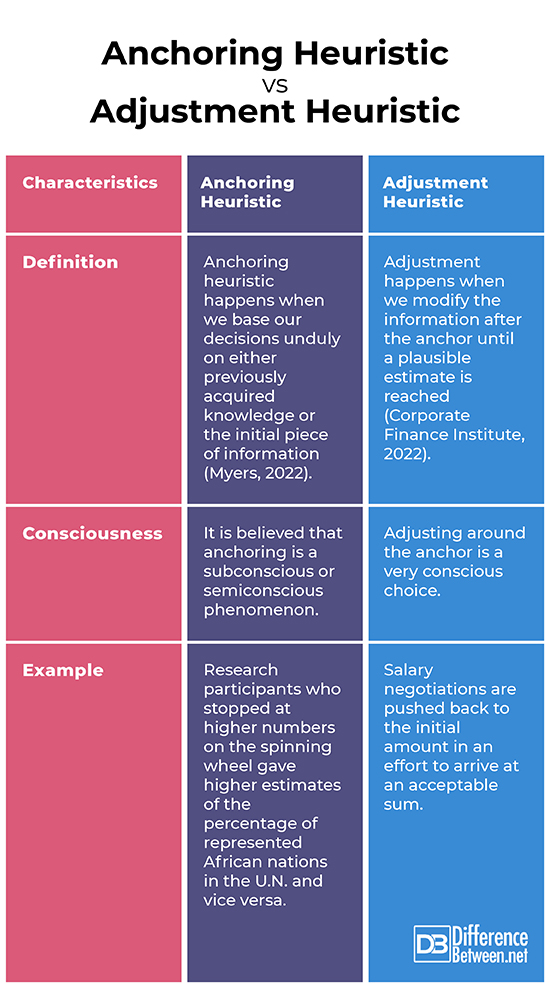Difference Between Anchoring Heuristic and Adjustment Heuristic
Anchoring heuristic and adjustment heuristic are closely related as evidenced by Tversky and Kahneman’s “anchoring-and-adjustment heuristic”. These mental shortcuts are often involved in intuitive and judgmental biases. Specifically, anchoring heuristic involves the initial piece of information. On the other hand, adjustment happens when there is a conscious decision around the anchor. The following discussions further delve into their differences.

What is Anchoring Heuristic?
When we base our decisions unduly on either previously acquired knowledge or the initial piece of information (the anchor), anchoring—which is strongly tied to the decision-making process—occurs (Myers, 2022). People tend to depend excessively on the very first piece of information they learn, which can have a significant impact on the choice they ultimately make.
Amos Tversky and Daniel Kahneman first proposed the concept of anchoring heuristic in 1974 with their work, “Judgment under Uncertainty: Heuristics and Biases”. Tversky and Kahneman, two of the most important names in behavioral economics, proposed the idea that when people attempt to make estimations or forecasts, they start with some initial value, or starting point, and then adjust from there. According to the anchor-and-adjust hypothesis, poor decisions are caused by the frequently insufficient cognitive modifications (The Decision Lab, 2022).
For example, Tversky and Kahneman conducted an experiment, they asked the research participants to spin a number-filled wheel and look at the number it stopped on. After that, the participants were tasked to estimate how many African nations were represented in the United Nations. Despite the fact that there was no association, those who stopped at higher numbers on the wheel believed the percentage to be higher, and vice versa (Master Class, 2022).

What is Adjustment Heuristic?
The anchoring-and-adjustment heuristic was introduced by Tversky and Kahneman; adjustment takes place after the anchoring. It happens when there is a conscious decision around the anchor or initial piece of information (Corporate Finance Institute, 2022). It is when we modify the information after the anchor until a plausible estimate is reached. One problem with adjustments is that they could be swayed by unrelated information that the person is contemplating and making erroneous links to the real target value. Individuals may view information via a fundamentally distorted lens by overemphasizing anchor points that are selected psychologically and statistically at random.
For example, when a recruiting manager suggests a starting pay, the adjustment happens when the negotiations may then be pushed back to that initial amount in an effort to arrive at an acceptable sum that was derived from the anchor (Walters, 2020).
Difference between Anchoring and Adjustment Heuristic
Definition
Anchoring heuristic happens when we base our decisions unduly on either previously acquired knowledge or the initial piece of information (Myers, 2022). As for adjustment, it is when we modify the information after the anchor until a plausible estimate is reached (Corporate Finance Institute, 2022).
Consciousness
It is believed that anchoring is a subconscious or semiconscious phenomenon, whereas adjusting around the anchor is a very conscious choice. Adjustment happens when there is a deliberate decision around the anchor or initial piece of information (Corporate Finance Institute, 2022).
Example
One example of anchoring is Tversky and Kahneman’s experiment; they asked the research participants to spin a number-filled wheel and look at the number it stopped on. After that, the participants were tasked to estimate how many African nations were represented in the UN. Despite the fact that there was no association, those who stopped at higher numbers on the wheel believed the percentage to be higher, and vice versa (Master Class, 2022). In comparison, an example for adjustment is when a recruiting manager suggests a starting pay; the adjustment happens when the negotiations may then be pushed back to that initial amount in an effort to arrive at an acceptable sum that was derived from the anchor (Walters, 2020).
Anchoring Heuristic vs Adjustment Heuristic

Frequently Asked Questions:
What is an example of anchoring heuristic?
One example of anchoring is Tversky and Kahneman’s experiment; they asked the research participants to spin a number-filled wheel and look at the number it stopped on. After that, the participants were tasked to estimate how many African nations were represented in the UN. Despite the fact that there was no association, those who stopped at higher numbers on the wheel believed the percentage to be higher, and vice versa (Master Class, 2022).
Is the anchoring effect a heuristic?
Yes, the anchoring heuristic, often referred to as focalism, is the propensity for people to accept and rely on the first piece of information they are presented with before making a choice.
What is the concept of anchoring?
Anchoring happens when we base our decisions unduly on either previously acquired knowledge or the initial piece of information (the anchor).
What is adjustment bias?
Individuals may view information via a fundamentally distorted lens by overemphasizing anchor points (initial information) that are selected psychologically and statistically at random. For example, when a recruiting manager suggests a starting pay, the adjustment happens when the negotiations may then be pushed back to that initial amount in an effort to arrive at an acceptable sum that was derived from the anchor (Walters, 2020).
How do you prevent adjustment bias and anchoring?
Such biases may be prevented by ensuring your decision has been the result of comprehensive investigation. It is helpful to first gather enough data before making decisions. For instance, utilizing a checklist or an assessment tool and asking sound advice from experts can help reduce cognitive bias.
What is the adjustment heuristic?
Adjustment takes place after the anchoring. It happens when there is a conscious decision around the anchor or initial piece of information (Corporate Finance Institute, 2022). It is when we modify the information after the anchor until a plausible estimate is reached.
What is anchoring in psychology?
Amos Tversky and Daniel Kahneman first proposed the concept of anchoring heuristic in 1974 with their work, “Judgment under Uncertainty: Heuristics and Biases”. Tversky and Kahneman, two of the most important names in behavioral economics, proposed the idea that when people attempt to make estimations or forecasts, they start with some initial value, or starting point, and then adjust from there (The Decision Lab, 2022).
What causes anchoring bias?
According to the anchor-and-adjust hypothesis, poor decisions are caused by the frequently insufficient cognitive modifications (The Decision Lab, 2022). People tend to depend excessively on the very first piece of information they learn, which can have a significant impact on the choice they ultimately make.
Summary
- Anchoring heuristic and adjustment heuristic are mental shortcuts often involved in intuitive and judgmental biases
- Anchoring heuristic happens when we base our decisions unduly on either previously acquired knowledge or the initial piece of information (Myers, 2022).
- Adjustment heuristic happens when we modify the information after the anchor until a plausible estimate is reached (Corporate Finance Institute, 2022).
- It is believed that anchoring is a subconscious or semiconscious phenomenon, whereas adjusting around the anchor is a very conscious choice (Corporate Finance Institute, 2022).
- Difference Between Hematoma and Melanoma - February 9, 2023
- Difference Between Bruising and Necrosis - February 8, 2023
- Difference Between Brain Hematoma and Brain Hemorrhage - February 8, 2023
Search DifferenceBetween.net :
Leave a Response
References :
[0]Corporate Finance Institute. (2022). Anchoring and adjustment. https://corporatefinanceinstitute.com/resources/knowledge/other/anchoring-and-adjustment/
[1]The Decision lab. (2022). Why we tend to rely to heavily upon the first piece of information we receive. https://thedecisionlab.com/biases/anchoring-bias
[2]Master Class. (2022). Anchoring bias: 5 examples of the psychology concept. https://www.masterclass.com/articles/anchoring-bias-explained#what-is-anchoring-bias
[3]Myers, E. (2022). How anchoring bias psychology affects decision making. Simply Psychology. https://www.simplypsychology.org/what-is-the-anchoring-bias.html
[4]Walters, T. (2020). Anchoring and adjustment. Investopedia. https://www.investopedia.com/terms/a/anchoring-and-adjustment.asp
